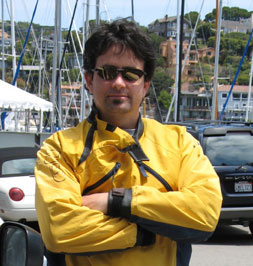W. Brian SimisonAssistant Curator and Director Center for Comparative Genomics
My research focus is on the global phylogeography of limpets (Gastropoda: Patellogastropoda). From this research my colleagues and I are examining the evolution and systematics of limpets and the mechanisms of vicariance, dispersal and speciation. Among the projects we are examining are: 1) The processes that lead to antitropical distributions (taxa found in both the northern and southern temperate regions, but not in the intervening tropical region). 2) The unique distribution of seagrass limpets in the southern most reaches of the Northeast Pacific temperate waters. This group of specialized limpets lives exclusively on the seagrasses Phylospadix and Zostera and they are the only temperate limpets that belong to the tropical New World limpet clade. The last known tropical New World seagrass limpet has been extinct for 5 million years. 3) We are actively searching for natural populations of the very rare Mexican limpet (Sutellastra mexicana). This is the largest species of limpet ever known (180cm) and unfortunately it has been collected to near extinction as a delicacy ingredient in ceviche and for its beautiful shell. We hope to publicize the fate of this endangered animal and get it added to the CITES species database. 4) The mechanisms of mitochondrial DNA strand bias and gene order variation and the associated consequences to phylogenetic analyses. As part of my research program I employ morphology, paleontology, ecology, behavior, sequence data and genomics. The newly created Center for Comparative Genomics will be available to all Academy researchers and will be an integral resource for my research program. This core facility will provide the opportunity to use molecular data above the nucleotide sequence level. Researchers will be able to generate amino acid data, secondary structure information, gene order data, fragment analyses for population studies, complete organellar and nuclear genomes, microarray analyses and large scale phylogenetic analyses to name a few. Our goal is to continue implementing and developing new techniques as the burgeoning field of comparative genomics expands. 1. Simison, W. Brian. and Boore, J. (In Press. 2007). Molluscan evolutionary genomics. In Phylogeny and Evolution of the Mollusca. (W. F. Ponder & D. R. Lindberg, eds.), University of California Press, Berkeley, CA. 2. Simison, W. Brian., Lindberg, D. R. and Boore, J. (2006). Rolling circle amplification of metazoan mitochondrial genomes. Molecular Phylogenetics and Evolution, 39:562-567. 3. Simison, W. Brian. (2006). Patterns of endemism for nearshore gastropod molluscs: A new view of the Gulf of California. Journal of Molluscan Studies, 72: 53-63. 4. Shi, H., J.F. Parham, W. Brian Simison, J. Wang, S. Gong, and B. Fu. (2005). A report on the wild hybridization between two species of threatened Asian box turtles (Testudines: Cuora) on Hainan Island, China. Amphibia-Reptilia, 26(3):377-381. 5. Espoz, Carmen, Lindberg, D. R., Castilla, J. C., and W. Brian Simison (2004). Intertidal limpets of Chile and Peru. Revista Chilena de Historia Natural. 77(2):257-283. 6. Simison, W. Brian, Lindberg, David R. (2003). On the identity of Lottia strigatella (Carpenter, 1864) (Patellogastropoda:Lottidae). The Veliger, 46:1-19. 7. Simison, W. Brian (2002). Plate Tectonics. Encyclopedia of Global Environmental Change. The Earth System: Physical & Chemical Dimensions of Global Environmental Change. 1:605-606. 8. Parham, J. F., W. Brian Simison, Kozak, K. H. Feldman, C. R., (2000). New Chinese turtles: Endangered or invalid? A reassessment of two species using mitochondrial DNA, allozyme electrophoresis and known-locality specimens. Animal Conservation, 4:357-457. 9. Simison, W. Brian, Lindberg, David R. (1999). Morphological and molecular resolution of a putative cryptic species complex: A case study of Notoacmea fascicularis (Menke, 1851) (Gastropoda: Patellogastropoda). Journal of Molluscan Studies, 65:99-109. |
|
|
||||||
|
|
||||||
| ||||||

 B.A., University of California San Diego (1985); Ph.D. University of California Berkeley (2000). Lecturer, University of California Berkeley (2005). NSF Post Doctoral Fellow, Joint Genome Institute (2003-2006). Post Doctoral Fellow Australian Museum, Sydney (2001-2002). Osher Lab manager (2007). Assistant Curator, California Academy of Sciences (2007-); Director of Center for Comparative Genomics (2007-)
B.A., University of California San Diego (1985); Ph.D. University of California Berkeley (2000). Lecturer, University of California Berkeley (2005). NSF Post Doctoral Fellow, Joint Genome Institute (2003-2006). Post Doctoral Fellow Australian Museum, Sydney (2001-2002). Osher Lab manager (2007). Assistant Curator, California Academy of Sciences (2007-); Director of Center for Comparative Genomics (2007-)